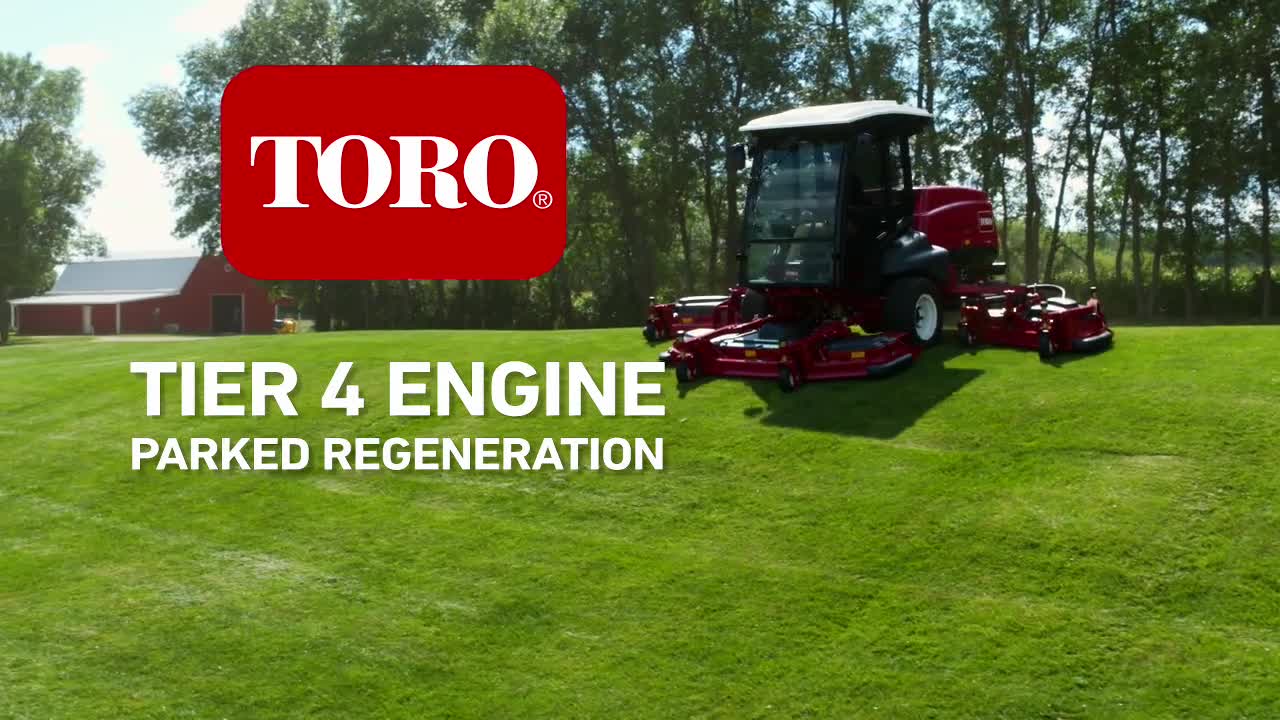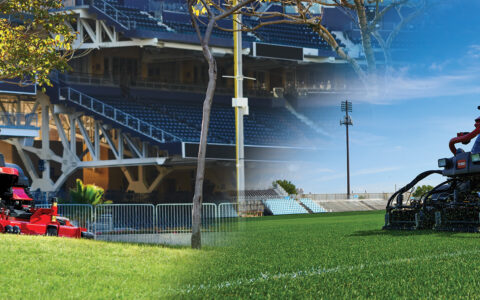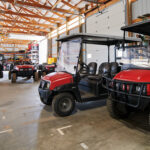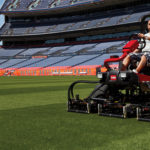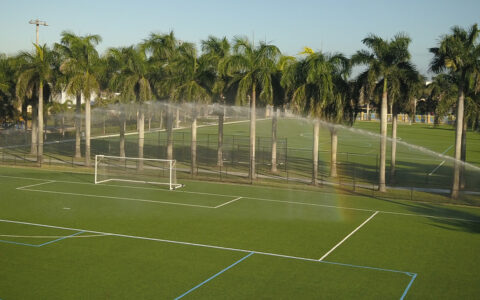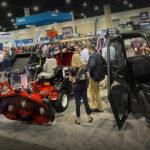This is part of a continuing series of “how to” articles to help you maximize performance and productivity with Toro® products. Watch future issues of Grounds for Success for more tips and information.
If a regeneration symbol appears on your Toro® product’s InfoCenter™ screen, don’t panic. It’s just there to let you know what’s happening with your machine’s engine.
So, what is regeneration and why is it needed? And what do those icons on your InfoCenter really mean? We turned to Toro’s Technical Service Team to help explain.
Why Regeneration?
Regeneration is all about removing the particulate matter, or unburnt fuel
(aka soot), from the diesel engine exhaust. It’s a normal and necessary part of
reducing harmful emissions in order to comply with EPA-mandated Tier 4
regulations.
Regeneration is the process of incinerating the soot that has collected in the soot filter. High heat burns the particulate matter and turns it into ash — which means the soot filter will eventually require cleaning as a normal maintenance requirement when regeneration will no longer clear the system completely.
Types of Regeneration
Yanmar® engines currently use five different regeneration
methods. Passive, Assist and Reset regeneration are automatic methods, and
Parked/Stationary and Recovery regeneration are manual methods.
1. Passive (self) regeneration occurs naturally from the engine’s combustion, which generates enough exhaust heat to burn off the particulate matter. No action is required and no icons are displayed on the InfoCenter.
2. Assist regeneration uses the throttle valve to reduce the amount of fresh air coming into the engine, which increases the exhaust temperature as a result. An icon is displayed on the InfoCenter; however, no action is required by the operator, and the machine may be operated as normal during this cycle.
3. Reset regeneration uses a combination of the intake throttle and post fuel injection to further raise the exhaust temperature to burn off the particulate matter. The High Exhaust Gas Temperature (EGT) icon is displayed on the InfoCenter, but no action is required by the operator unless prompted by the advisories on the screen. The machine may be operated as normal during this cycle. Note: An advisory will be displayed recommending running your engine at full throttle during a Reset regeneration to help with this process.
4. Parked/Stationary
regeneration is used
when the Passive, Assist and Reset regenerations do not adequately reduce the
soot in the soot filter. This process requires the operator or technician to
start a Parked regeneration within the InfoCenter’s Service menu (it typically
takes about 30 minutes). The regeneration cycle must be performed while the
machine is parked.
When the Parked/Stationary regeneration is required, the display will prompt
the user every 15 minutes with an advisory on the InfoCenter that a Parked
regen is required, and the operator should perform this process as soon as
possible. The unit will only permit the operator to wait two hours maximum
before disabling the PTO on units that are so equipped. If this
regeneration request is ignored, engine performance will degrade and unplanned
machine downtime may result.
5. Recovery regeneration is the most advanced level of DPF cleaning. The machine must be parked during the Recovery regen cycle and the process can take up to 90 minutes. The InfoCenter will prompt the operator with an advisory that a Recovery regen is required and the PTO will be disabled on the unit. Once the Recovery regeneration process completes, the engine returns to normal operation.
Symbols and
What They Mean
The following InfoCenter icons are designed to provide quick,
easy-to-understand information about the regeneration processes that are needed
or taking place.
Note: Be sure to read and understand any advisories for additional instructions and information.

- High Exhaust Gas Temperature (EGT):Meaning: Assist or Reset regeneration is in process. • High exhaust temperatures are possible.• No action is required from the operator.• Continue operating machine normally.• The thermometer symbol will fill as the temp rises. When it’s full, the process is nearly complete.
- Regen Requested: Meaning: Parked/Stationary or Recovery regeneration is needed now.• Ensure adequate fuel is available to complete the process (fuel level minimum 1/4 full).• Follow InfoCenter prompts.• The parking brake should be applied.• The engine should be at idle.• The coolant temp should be greater than 140˚F.
- Regen Active: Meaning: Displayed when Parked or Recovery regen cycle is running.
- PTO Disabled: Meaning: Displayed when the PTO has been disabled.
Where to Find More Information
If you want to know more about what’s happening with your machine’s engine regeneration system, it’s right at your fingertips. Just go to the SERVICE menu in the InfoCenter display and choose from these options:
• Inhibit Regen (On/Off) – Should be left in the OFF state. This permits an operator to prevent Reset regeneration cycles from running automatically. The operator should not inhibit regen unless there is a serious concern about elevated exhaust gas temperatures occurring. Inhibit Regen defaults to OFF when the machine is turned on.
• Parked Regen – Used to start a Parked regen cycle when requested or desired by the operator. May also be used to cancel a Parked regen cycle when the cycle is running.
• Time Since Regen – Time since last successful Reset, Parked or Recovery regen cycle. A regen is only allowed when the last regen was more than 50 hours ago.
• Recovery Regen – Used to start a Recovery regen cycle when requested by the engine. This will only be enabled if the engine is requesting a Recovery regen. May also be used to cancel a Recovery regen cycle when the cycle is running.
The TECHNICIAN sub-menu contains additional information, not only for technicians, but also for anyone looking to confirm the current state of the engine and whether the machine is in regen mode. Options in this menu include:
• Current State – Current engine regen control state – information only.
• Soot Load – DPF soot load in percent reported by engine.
Soot Load Percent and Regen
Cycles
The engine controller reports the DPF soot load as a value from 0% to 250%
— not 0% to 100% as you may expect. The value may fluctuate, and this is
normal. Here’s what those percentages mean:
Above Soot Load 78%: Reset regeneration is activated by the engine ECU.
At Soot Load 100%: Parked regeneration is requested by the engine ECU.
At Soot Load 122%: Recovery regeneration is requested by the engine ECU.
Important
Maintenance Reminders
Using the right types of diesel fuel and engine oil is also critical to
keep your Tier 4 engine performing reliably. Ultra-low sulfur diesel fuel (less
than 15 parts-per-million sulfur content) is absolutely required for use in all
Tier 4 engines for both regulatory and technical reasons. Diesel fuel with
higher than 15 ppm sulfur content can degrade the diesel oxidation catalyst
(DOC), which can potentially cause operational problems and may jeopardize
long-term component life.
In addition, Tier 4 diesel engines require CJ-4 specification (or higher) low-ash oil. CJ-4 engine oil is engineered to sustain emission control system durability with diesel particulate filters used on Tier 4 engines. Using engine oils other than CJ-4 can cause premature clogging of the DPF and a subsequent reduction in engine performance.
Learn More
For more information about Tier 4 regeneration, download this informational brochure, visit our Tier 4 information page, or contact your local Toro distributor.
